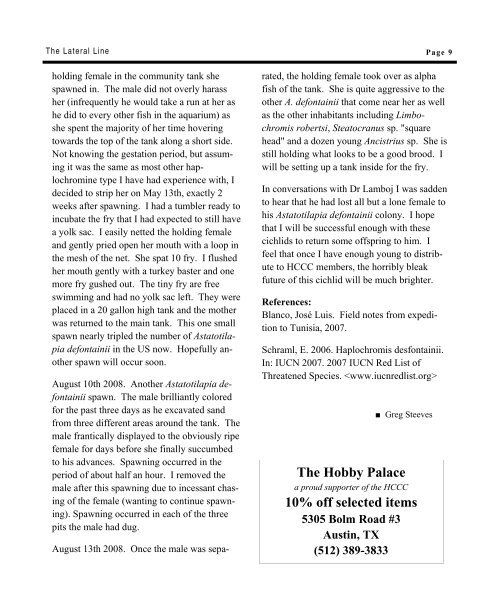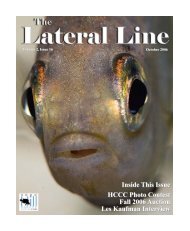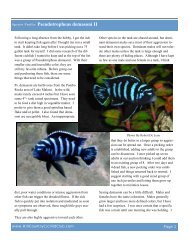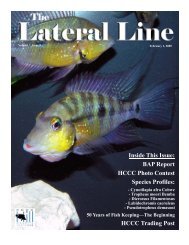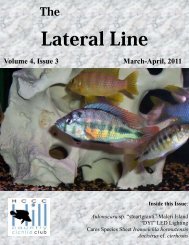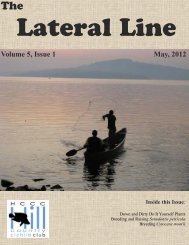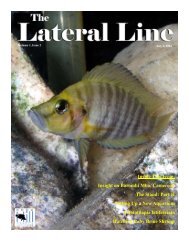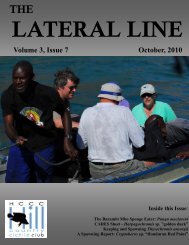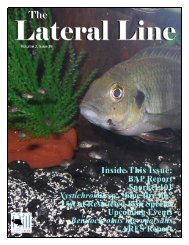August/September - Hill Country Cichlid Club
August/September - Hill Country Cichlid Club
August/September - Hill Country Cichlid Club
You also want an ePaper? Increase the reach of your titles
YUMPU automatically turns print PDFs into web optimized ePapers that Google loves.
The Lateral Line Page 9<br />
holding female in the community tank she<br />
spawned in. The male did not overly harass<br />
her (infrequently he would take a run at her as<br />
he did to every other fish in the aquarium) as<br />
she spent the majority of her time hovering<br />
towards the top of the tank along a short side.<br />
Not knowing the gestation period, but assuming<br />
it was the same as most other haplochromine<br />
type I have had experience with, I<br />
decided to strip her on May 13th, exactly 2<br />
weeks after spawning. I had a tumbler ready to<br />
incubate the fry that I had expected to still have<br />
a yolk sac. I easily netted the holding female<br />
and gently pried open her mouth with a loop in<br />
the mesh of the net. She spat 10 fry. I flushed<br />
her mouth gently with a turkey baster and one<br />
more fry gushed out. The tiny fry are free<br />
swimming and had no yolk sac left. They were<br />
placed in a 20 gallon high tank and the mother<br />
was returned to the main tank. This one small<br />
spawn nearly tripled the number of Astatotilapia<br />
defontainii in the US now. Hopefully another<br />
spawn will occur soon.<br />
<strong>August</strong> 10th 2008. Another Astatotilapia defontainii<br />
spawn. The male brilliantly colored<br />
for the past three days as he excavated sand<br />
from three different areas around the tank. The<br />
male frantically displayed to the obviously ripe<br />
female for days before she finally succumbed<br />
to his advances. Spawning occurred in the<br />
period of about half an hour. I removed the<br />
male after this spawning due to incessant chasing<br />
of the female (wanting to continue spawning).<br />
Spawning occurred in each of the three<br />
pits the male had dug.<br />
<strong>August</strong> 13th 2008. Once the male was separated,<br />
the holding female took over as alpha<br />
fish of the tank. She is quite aggressive to the<br />
other A. defontainii that come near her as well<br />
as the other inhabitants including Limbochromis<br />
robertsi, Steatocranus sp. "square<br />
head" and a dozen young Ancistrius sp. She is<br />
still holding what looks to be a good brood. I<br />
will be setting up a tank inside for the fry.<br />
In conversations with Dr Lamboj I was sadden<br />
to hear that he had lost all but a lone female to<br />
his Astatotilapia defontainii colony. I hope<br />
that I will be successful enough with these<br />
cichlids to return some offspring to him. I<br />
feel that once I have enough young to distribute<br />
to HCCC members, the horribly bleak<br />
future of this cichlid will be much brighter.<br />
References:<br />
Blanco, José Luis. Field notes from expedition<br />
to Tunisia, 2007.<br />
Schraml, E. 2006. Haplochromis desfontainii.<br />
In: IUCN 2007. 2007 IUCN Red List of<br />
Threatened Species. <br />
■ Greg Steeves<br />
The Hobby Palace<br />
a proud supporter of the HCCC<br />
10% off selected items<br />
5305 Bolm Road #3<br />
Austin, TX<br />
(512) 389-3833


